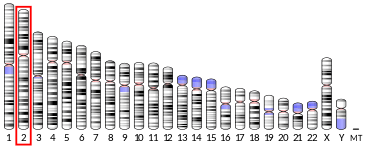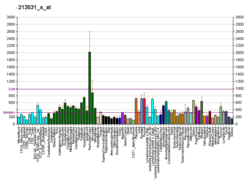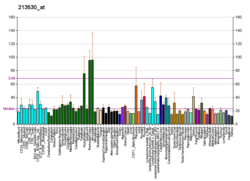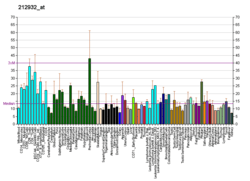RAB3GAP1
Rab3 GTPase-activating protein catalytic subunit is an enzyme that in humans is encoded by the RAB3GAP1 gene.[5][6][7]
Function
Members of the RAB3 protein family (see RAB3A; MIM 179490) are implicated in regulated exocytosis of neurotransmitters and hormones. RAB3GAP, which is involved in regulation of RAB3 activity, is a heterodimeric complex consisting a 130-kD catalytic subunit and a 150-kD noncatalytic subunit (MIM 609275). RAB3GAP specifically converts active RAB3-GTP to the inactive form RAB3-GDP (Aligianis et al., 2005).[supplied by OMIM][7] RAB3GAP is reported to modulate basal and rapamycin-induced autophagy in human fibroblasts and C. elegans.[8] Further, the RAB3GAP1 knockdown has shown to affect the autophagy and mineralization potential of human primary osteoblasts.[9]
See also
- Micro syndrome
- RAB3GAP2 - the 150-kD noncatalytic subunit of RAB3GAP complex
- Tbc domain
References
- GRCh38: Ensembl release 89: ENSG00000115839 - Ensembl, May 2017
- GRCm38: Ensembl release 89: ENSMUSG00000036104 - Ensembl, May 2017
- "Human PubMed Reference:". National Center for Biotechnology Information, U.S. National Library of Medicine.
- "Mouse PubMed Reference:". National Center for Biotechnology Information, U.S. National Library of Medicine.
- Fukui K, Sasaki T, Imazumi K, Matsuura Y, Nakanishi H, Takai Y (Feb 1997). "Isolation and characterization of a GTPase activating protein specific for the Rab3 subfamily of small G proteins". The Journal of Biological Chemistry. 272 (8): 4655–4658. doi:10.1074/jbc.272.8.4655. PMID 9030515.
- Aligianis IA, Johnson CA, Gissen P, Chen D, Hampshire D, Hoffmann K, Maina EN, Morgan NV, Tee L, Morton J, Ainsworth JR, Horn D, Rosser E, Cole TR, Stolte-Dijkstra I, Fieggen K, Clayton-Smith J, Mégarbané A, Shield JP, Newbury-Ecob R, Dobyns WB, Graham JM, Kjaer KW, Warburg M, Bond J, Trembath RC, Harris LW, Takai Y, Mundlos S, Tannahill D, Woods CG, Maher ER (Mar 2005). "Mutations of the catalytic subunit of RAB3GAP cause Warburg Micro syndrome". Nature Genetics. 37 (3): 221–223. doi:10.1038/ng1517. PMID 15696165.
- "Entrez Gene: RAB3GAP1 RAB3 GTPase activating protein subunit 1 (catalytic)".
- Spang, Natalie; Feldmann, Anne; Huesmann, Heike; Bekbulat, Fazilet; Schmitt, Verena; Hiebel, Christof; Koziollek-Drechsler, Ingrid; Clement, Albrecht M; Moosmann, Bernd; Jung, Jennifer; Behrends, Christian; Dikic, Ivan; Kern, Andreas; Behl, Christian (12 December 2014). "RAB3GAP1 and RAB3GAP2 modulate basal and rapamycin-induced autophagy". Autophagy. 10 (12): 2297–2309. doi:10.4161/15548627.2014.994359. PMC 4502700. PMID 25495476.
- Gavali, Shubhangi; Gupta, Manoj Kumar; Daswani, Bhavna; Wani, Mohan R.; Sirdeshmukh, Ravi; Khatkhatay, M. Ikram (September 2019). "Estrogen enhances human osteoblast survival and function via promotion of autophagy". Biochimica et Biophysica Acta (BBA) - Molecular Cell Research. 1866 (9): 1498–1507. doi:10.1016/j.bbamcr.2019.06.014. PMID 31255720.
Further reading
- Nomura N, Nagase T, Miyajima N, Sazuka T, Tanaka A, Sato S, Seki N, Kawarabayasi Y, Ishikawa K, Tabata S (1995). "Prediction of the coding sequences of unidentified human genes. II. The coding sequences of 40 new genes (KIAA0041-KIAA0080) deduced by analysis of cDNA clones from human cell line KG-1". DNA Research. 1 (5): 223–229. doi:10.1093/dnares/1.5.223. PMID 7584044.
- Warburg, Mette; Sjö, O; Fledelius, HC; Pedersen, SA (1 December 1993). "Autosomal Recesssive Microcephaly, Microcornea, Congenital Cataract, Mental Retardation, Optic Atrophy, and Hypogenitalism". American Journal of Diseases of Children. 147 (12): 1309–12. doi:10.1001/archpedi.1993.02160360051017. PMID 8249951.
- Nagano F, Sasaki T, Fukui K, Asakura T, Imazumi K, Takai Y (Sep 1998). "Molecular cloning and characterization of the noncatalytic subunit of the Rab3 subfamily-specific GTPase-activating protein". The Journal of Biological Chemistry. 273 (38): 24781–24785. doi:10.1074/jbc.273.38.24781. PMID 9733780.
- Oishi, Hideto; Sasaki, Takuya; Nagano, Fumiko; Ikeda, Wataru; Ohya, Takeshi; Wada, Manabu; Ide, Nobuyuki; Nakanishi, Hiroyuki; Takai, Yoshimi (18 December 1998). "Localization of the Rab3 Small G Protein Regulators in Nerve Terminals and Their Involvement in Ca2+-dependent Exocytosis". Journal of Biological Chemistry. 273 (51): 34580–34585. doi:10.1074/jbc.273.51.34580. PMID 9852129.
- Rodríguez Criado G, Rufo M, Gómez de Terreros I (Oct 1999). "A second family with Micro syndrome". Clinical Dysmorphology. 8 (4): 241–245. doi:10.1097/00019605-199910000-00002. PMID 10532171.
- Clabecq A, Henry JP, Darchen F (Oct 2000). "Biochemical characterization of Rab3-GTPase-activating protein reveals a mechanism similar to that of Ras-GAP". The Journal of Biological Chemistry. 275 (41): 31786–31791. doi:10.1074/jbc.M003705200. PMID 10859313.
- Kawabe, Hiroshi; Sakisaka, Toshiaki; Yasumi, Masato; Shingai, Tatsushi; Izumi, Genkichi; Nagano, Fumiko; Deguchi-Tawarada, Maki; Takeuchi, Masakazu; Nakanishi, Hiroyuki; Takai, Yoshimi (June 2003). "A novel rabconnectin-3-binding protein that directly binds a GDP/GTP exchange protein for Rab3A small G protein implicated in Ca2+-dependent exocytosis of neurotransmitter". Genes to Cells. 8 (6): 537–546. doi:10.1046/j.1365-2443.2003.00655.x. PMID 12786944.
- Cheviet, Séverine; Coppola, Thierry; Haynes, Lee P.; Burgoyne, Robert D.; Regazzi, Romano (1 January 2004). "The Rab-Binding Protein Noc2 Is Associated with Insulin-Containing Secretory Granules and Is Essential for Pancreatic β-Cell Exocytosis". Molecular Endocrinology. 18 (1): 117–126. doi:10.1210/me.2003-0300. PMID 14593078.
- Olsen JV, Blagoev B, Gnad F, Macek B, Kumar C, Mortensen P, Mann M (Nov 2006). "Global, in vivo, and site-specific phosphorylation dynamics in signaling networks". Cell. 127 (3): 635–648. doi:10.1016/j.cell.2006.09.026. PMID 17081983.
- Tsuritani K, Irie T, Yamashita R, Sakakibara Y, Wakaguri H, Kanai A, Mizushima-Sugano J, Sugano S, Nakai K, Suzuki Y (Jul 2007). "Distinct class of putative "non-conserved" promoters in humans: comparative studies of alternative promoters of human and mouse genes". Genome Research. 17 (7): 1005–1014. doi:10.1101/gr.6030107. PMC 1899111. PMID 17567985.






